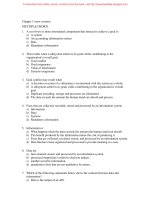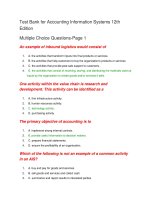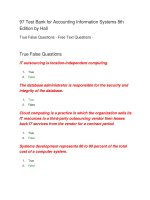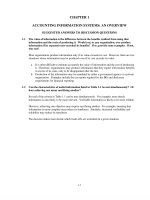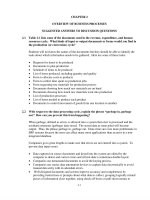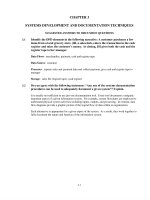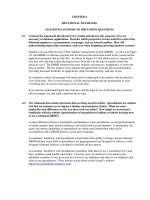Solution manual accounting information systems 12th edition by romney and steinbart CH02
Bạn đang xem bản rút gọn của tài liệu. Xem và tải ngay bản đầy đủ của tài liệu tại đây (465.93 KB, 19 trang )
Find more on www.downloadslide.com
CHAPTER 2
OVERVIEW OF BUSINESS PROCESSES
SUGGESTED ANSWERS TO DISCUSSION QUESTIONS
2.1 Table 2-1 lists some of the documents used in the revenue, expenditure, and human
resources cycle. What kinds of input or output documents or forms would you find in
the production (or conversion) cycle?
Students will not know the names of the documents but they should be able to identify the
tasks about which information needs to be gathered. Here are some of those tasks:
Requests for items to be produced
Documents to plan production
Schedule of items to be produced
List of items produced, including quantity and quality
Form to allocate costs to products
Form to collect time spent on production jobs
Form requesting raw materials for production process
Documents showing how much raw materials are on hand
Documents showing how much raw materials went into production
List of production processes
List of items needed to produce each product
Documents to control movement of goods from one location to another
2.2 With respect to the data processing cycle, explain the phrase “garbage in, garbage
out.” How can you prevent this from happening?
When garbage, defined as errors, is allowed into a system that error is processed and the
resultant erroneous (garbage) data stored. The stored data at some point will become
output. Thus, the phrase garbage in, garbage out. Data errors are even more problematic in
ERP systems because the error can affect many more applications than an error in a nonintegrated database.
Companies go to great lengths to make sure that errors are not entered into a system. To
prevent data input errors:
Data captured on source documents and keyed into the system are edited by the
computer to detect and correct errors and critical data is sometimes double keyed.
Companies use turnaround documents to avoid the keying process.
Companies use source data automation devices to capture data electronically to avoid
manual data entry with its attendant errors.
Well-designed documents and screens improve accuracy and completeness by
providing instructions or prompts about what data to collect, grouping logically related
pieces of information close together, using check off boxes or pull-down menus to
2-1
Find more on www.downloadslide.com
Ch. 2: Overview of Business Processes
present the available options, and using appropriate shading and borders to clearly
separate data items.
Data input screens are preformatted to list all the data the user needs to enter.
Prenumbered source documents are used or the system automatically assigns a
sequential number to each new transaction. This simplifies verifying that all
transactions have been recorded and that none of the documents has been misplaced.
The system is programmed to make sure company policies are followed, such as
approving or verifying a transaction. For example, the system can be programmed to
check a customer’s credit limit and payment history, as well as inventory status, before
confirming a sale to a customer.
2.3 What kinds of documents are most likely to be turnaround documents? Do an
internet search to find the answer and to find example turnaround documents.
Documents that are commonly used as turnaround documents include the following:
Utility bills
Meter cards for collecting readings from gas meters, photocopiers, water meters etc
Subscription renewal notices
Inventory stock cards
Invoices
Checks (banks encode account info on the bottom of checks)
Annual emissions inventory forms
( /> Adult Literary Information and Evaluation System forms
( />Students will find many other turnaround documents.
Here are some URLs for turnaround document definitions and examples:
/> /> />Here are some turnaround document images (1 long URL):
/>2.4 The data processing cycle in Figure 2-1 is an example of a basic process found
throughout nature. Relate the basic input/process/store/output model to the functions
of the human body.
There are a number of ways to relate the input/process/store/output model to the human
2-2
Find more on www.downloadslide.com
Accounting Information Systems
body. Here are a few of them
Brain. We read, see, hear, and feel things. We process that input in order to understand
what it is and how it relates to us. We store that data in our brains and then process it
again in order to produce solve problems, make decisions, etc., which represent output.
Stomach. We take food in as input. It is processed to produce energy to fuel all bodily
functions. If we eat more food than the body needs at any one time it is stored as fat.
The output is walking, talking, thinking – all functions fueled by the energy produced.
Human waste is also an output of that process.
Students will come up with other examples of how the input/process/store/output model
applies to the human body
2.5 Some individuals argue that accountants should focus on producing financial
statements and leave the design and production of managerial reports to information
systems specialists. What are the advantages and disadvantages of following this
advice? To what extent should accountants be involved in producing reports that
include more than just financial measures of performance? Why?
There are no advantages to accountants focusing only on financial information. Both the
accountant and the organization would suffer if this occurred. Moreover, it would be very
costly to have two systems rather than one that captures and processes operational facts at
the same time as it captures and reports financial facts.
The main disadvantage of this is that accountants would ignore much relevant information
about the organization’s activities. To the extent that such nonfinancial information (e.g.,
market share, customer satisfaction, measures of quality, etc.) is important to management,
the value of the accounting function would decline. Moreover, accountants have been
trained in how to design systems to maximize the reliability of the information produced.
If relevant information is not produced by the AIS, there is danger that the information may
be unreliable because the people responsible for its production have not been trained in, or
adequately aware of, the potential threats to reliability and the best measures for dealing
with those threats.
2-3
Find more on www.downloadslide.com
Ch. 2: Overview of Business Processes
SUGGESTED ANSWERS TO THE PROBLEMS
2.1 The chart of accounts must be tailored to an organization’s specific needs. Discuss
how the chart of accounts for the following organizations would differ from the one
presented for S&S in Table 2-2.
Some of the changes in the chart of accounts for each type of entity include the following:
a.
b.
c.
University
No equity or summary drawing accounts. Instead, have a fund balances section
for each type of fund.
Several types of funds, with a separate chart of accounts for each. The current
fund is used for operating expenses, but not capital expenditures. Loan funds are
used to account for scholarships and loans. Endowment funds are used to account
for resources obtained from specific donors, generally with the objective that
principal be preserved and that income be used for a specific purpose. Plant funds
are used for major capital expenditures. Most fund categories would be further
divided into restricted and unrestricted categories.
Unlikely to have Notes Receivable, but may have Accounts Receivable for
students who pay tuition in installment payments.
Tuition and fees would be one so������������������������������������������������������������������������������������������������������������������������������������������������������������������������������������������������������������������������������������������������������������������������������������������������������������������������������������������������������������������������������������������������������������������������������������������������������������������������������������������������������������������������������������������������������������������������������������������������������������������������������������������������������������������������������������������������������������������������������������������������������������������������������������������������������������������������������������������������������������������������������������������������������������������������������������������������������������������������������������������������������������������������������������������������������������������������������������������������������������������������������������������������������������������������������������������������������������������������������������������������������������������������������������������������������������������������������������������������������������������������������������������������������������������������������������������������������������������������������������������������������������������������������������������������������������������������������������������������������������������������������������������������������������������������������������������������������������������������������������������������������������������������������������������������������������������������������������������������������������������������������������������������������������������������������������������������������������������������������������������������������������������������������������������������������������������������������������������������������������������������������������������������������������������������������������������������������������������������������������������������������������������������������������������������������������������������������������������������������������������������������������������������������������������������������������������������������������������������������������������������������������������������������������������������������������������������������������������������������������������������������������������������������������������������������������������������������������������������������������������������������������������������������������������������������������������������������������������������������������������������������������������������������������������������������������������������������������������������������������������������������������������������������������������������������������������������������������������������������������������������������������������������������������������������������������������������������������������������������������������������������������������������������������������������������������������������������������������������������������������������������������������������������������������������������������������������������������������������������������������������������������������������������������������������������������������������������������������������������������������������������������������������������������������������������������������������������������������������������������������������������������������������������������������������������������������������������������������������������������������������������������������������������������������������������������������������������������������������������������������������������������������������������������������������������������������������������������������������������������������������������������������������������������������������������������������������������������������������������������������������������������������������������������������������������������������������������������������������������������������������������������������������������������������������������������������������������������������������������������������������������������������������������������������������������������������������������������������������������������������������������������������������������������������������������������������������������������������������������������������������������������������������������������������������������������������������������������������������������������������������������������������������������������������������������������������������������������������������������������������������������������������������������������������������������������������������������������������������������������������������������������������������������������������������������������������������������������������������������������������������������������������������������������������������������������������������������������������������������������������������������������������������������������������������������������������������������������������������������������������������������������������������������������������������������������������������������������������������������������������������������������������������������������������������������������������������������������������������������������������������������������������������������������������������������������������������������������������������������������������������������������������������������������������������������������������������������������������������������������������������������������������������������������������������������������������������������������������������������������������������������������������������������������������������������������������������������������������������������������������������������������������������������������������������������������������������������������������������������������������������������������������������������������������������������������������������������������������������������������������������������������������������������������������������������������������������������������������������������������������������������������������������������������������������������������������������������������������������������������������������������������������������������������������������������������������������������������������������������������������������������������������������������������������������������������������������������������������������������������������������������������������������������������������������������������������������������������������������������������������������������������������������������������������������������������������������������������������������������������������������������������������������������������������������������������������������������������������������������������������������������������������������������������������������������������������������������������������������������������������������������������������������������������������������������������������������������������������������������������������������������������������������������������������������������������������������������������������������������������������������������������������������������������������������������������������������������������������������������������������������������������������������������������������������������������������������������������������������������������������������������������������������������������������������������������������������������������������������������������������������������������������������������������������������������������������������������������������������������������������������������������������������������������������������������������������������������������������������������������������������������������������������������������������������������������������������������������������������������������������������������������������������������������������������������������������������������������������������������������������������������������������������������������������������������������������������������������������������������������������������������������������������������������������������������������������������������������������������������������������������������������������������������������������������������������������������������������������������������������������������������������������������������������������������������������������������������������������������������������������������������������������������������������������������������������������������������������������������������������������������������������������������������������������������������������������������������������������������������������������������������������������������������������������������������������������������������������������������������������������������������������������������������������������������������������������������������������������������������������������������������������������������������������������������������������������������������������������������������������������������������������������������������������������������������������������������������������������������������������������������������������������������������������������������������������������������������������������������������������������������������������������������������������������������������������������������������������������������������������������������������������������������������������������������������������������������������������������������������������������������������������������������������������������������������������������������������������������������������������������������������������������������������������������������������������������������������������������������������������������������������������������������������������������������������������������������������������������������������������������������������������������������������������������������������������������������������������������������������������������������������������������������������������������������������������������������������������������������������������������������������������������������������������������������������������������������������������������������������������������������������������������������������������������������������������������������������������������������������������������������������������������������������������������������������������������������������������������������������������������������������������������������������������������������������������������������������������������������������������������������������������������������������������������������������������������������������������������������������������������������������������������������������������������������������������������������������������������������������������������������������������������������������������������������������������������������������������������������������������������������������������������������������������������������������������������������������������������������������������������������������������������������������������������������������������������������������������������������������������������������������������������������������������������������������������������������������������������������������������������������������������������������������������������������������������������������������������������������������������������������������������������������������������������������������������������������������������������������������������������������������������������������������������������������������������������������������������������������������������������������������������������������������������������������������������������������������������������������������������������������������������������������������������������������������������������������������������������������������������������������������������������������������������������������.
Update customer address change
Update unit pricing information
Record daily sales
Record payroll checks
Change employee pay rates
Record production run variances
Record Sales Commissions
Change employee office location
Update accounts payable balance
Change customer credit limit
Change vendor payment discount terms
Record purchases
2-14
– Master file
– Master file
– Transaction file
– Transaction file
– Master file
– Transaction file
– Transaction file
– Master file
– Master file
– Master file
– Master file
– Transaction file
Find more on www.downloadslide.com
Accounting Information Systems
2.9 You were hired to assist Ashton Fleming in designing an accounting system for S&S.
Ashton has developed a list of the journals, ledgers, reports, and documents that he
thinks S&S needs (see Table 2-6). He asks you to complete the following tasks:
No single answer exists with this case. Indeed, solutions will vary depending upon student
ingenuity and creativity. Student answers can be compared to examples of these
documents found in chapters 12, 13, and 15.
a.
Specify what data you think should be collected on each of the following four
documents: sales invoice, purchase order, receiving report, employee time card
A sample invoice is presented in the Revenue Cycle chapter. A sample purchase
order is presented in the Expenditure Cycle chapter. A sample receiving report also
appears in the Expenditure Cycle chapter. Although student designs will vary, each
document should contain the following data items:
Sales Invoice
Customer name and address
Customer account number
Customer order number
Salesperson code
Shipping Address
Shipper and date shipped
Terms of sale
Total Amount due
Purchase Order
Ship to address
Bill to address
Purchasing agent number
Quantity of parts ordered
Prices of parts ordered
Taxes, if any
Receiving Report
Vendor name
Vendor address
Shipper
Quantity received
Description/quality remarks
Inspected by
Product code or number
Product description
Quantity ordered
Quantity shipped
Unit price
Extended price
Taxes, if applicable
Item numbers ordered
Payment terms
Shipping instructions
Supplier name or number
Date of purchase
Total amount of purchase
Vendor number
Date received
Receiving clerk number
Part number received
Purchase order number
Employee Time Card
2-15
Find more on www.downloadslide.com
Ch. 2: Overview of Business Processes
Employee name
Employee number
Pay period
Department number
Employee signature
b.
Total regular hours
Time in/ Time out
Total overtime hours
Approved by
Design a report to manage inventory
The report to manage inventory should contain the following information:
c.
Preferred vendor
Product number
Description
Reorder point
Quantity on Hand
Quantity Available
Vendor performance history
Quantity on order
Lead time
Design a report to assist in managing credit sales and cash collections.
The report to manage credit sales and cash collections should include:
d.
Credit sales per period
Cash collections per period
Aging of accounts receivable
Customers by geographic region
Uncollectible accounts per period
Visit a local office supply store and identify what types of journals, ledgers, and
blank forms for various documents (sales invoices, purchase orders, etc.) are
available. Describe how easily they could be adapted to meet S&S’s needs.
The answers to this will vary depending upon the types of documents carried in the
office supplies stores visited by the students.
A fruitful topic for class discussion, or a possible additional case assignment, is to
compare the design of paper documents to the data entry screen layouts used in
various popular accounting packages.
2-16
Find more on www.downloadslide.com
Accounting Information Systems
SUGGESTED ANSWERS TO THE CASES
2.1 Bar Harbor Blueberry Farm
Data from Case
Date
Supplier
Invoice
Supplier Name
Supplier
Address
Amount
March 7
AJ34
Bud’s Soil Prep, Inc.
PO Box 34
$2,067.85
March 11
14568
Osto Farmers Supply
45 Main
$
March 14
893V
Whalers Fertilizer, Inc.
Route 34
$5,000.00
March 21
14699
Osto Farmers Supply
45 Main
$3,450.37
March 21
10102
IFM Package Wholesale
587 Longview
$4,005.00
March 24
10145
IFM Package Wholesale
587 Longview
$ 267.88
67.50
Purchases Journal
Page 1
Date
Supplier
Supplier
Invoice
Account
Number
Post
Ref
Amount
March 7
Bud’s Soil Prep, Inc.
AJ34
23
√
$2,067.85
March 11
Osto Farmers Supply
14568
24
√
$
March 14
Whalers Fertilizer, Inc.
893V
36
√
$5,000.00
March 21
Osto Farmers Supply
14699
24
√
$3,450.37
March 21
IFM Package
Wholesale
10102
38
√
$4,005.00
March 24
IFM Package
Wholesale
10145
38
√
$ 267.88
March 31
TOTAL
67.50
14,858.60
2-17
Find more on www.downloadslide.com
Ch. 2: Overview of Business Processes
General Ledger
Accounts Payable
Date
Description
March 1
Balance
Forward
Account Number: 300
Post Ref
Debit
14,858.60
Purchases
33,594.15
Account Number: 605
Date
Description
March 1
Balance
Forward
March 31
Balance
$18,735.55
√
March 31
Credit
Post Ref
Debit
Credit
Balance
$54,688.49
√
14,858.60
2-18
69,547.09
Find more on www.downloadslide.com
Accounting Information Systems
Account Payable Subsidiary Ledger
Account No: 23 Bud’s Soil Prep, Inc.
Date
Description
March
Balance Forward
1
March
Mulch
7
PO Box 34
Debit
Account No: 24 Osto Farmers Supply
Date
Description
March
Balance Forward
1
Mar 11 Seedling Heat Mat
Mar 21 Medium Portable
Greenhouse
45 Main
Debit
Account No: 36
Route 34
Date
March
1
March
14
Whalers Fertilizer,
Inc.
Description
Balance Forward
2,067.85
Debit
587 Longview
Debit
2-19
2,067.85
Terms: 2/10, Net 30
Credit
Balance
0.00
67.50
3,450.37
Premium Leaf-Blend
Fertilizer
Account No: 38 IFM Package
Wholesale
Date
Description
March
Balance Forward
1
Mar 21 Peat Pots
Mar 24 Labels
Terms: 2/10, Net 30
Credit
Balance
0.00
67.50
3,517,87
Terms: 2/10, Net 30
Credit
Balance
0.00
5,000.00
5,000.00
Terms: 2/10, Net 30
Credit
Balance
0.00
4,005.00
267.88
4,005.00
4,272.88
